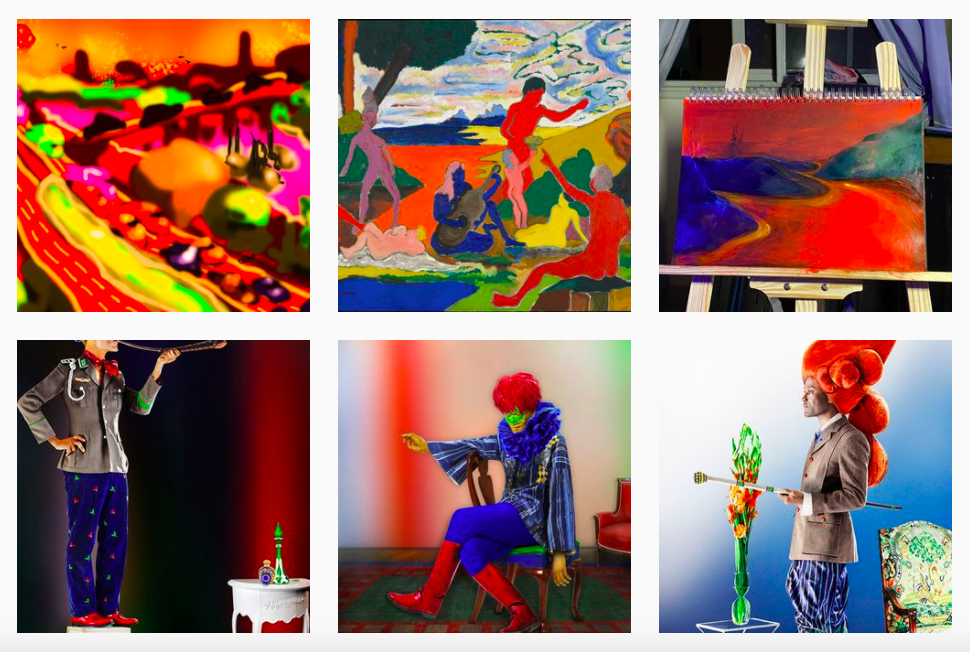Using Iké Udé’s luminously neon print Sartorial Anarchy #5 as its primary point of reference, this Instagram-based project seeks to explore and analyze two varying approaches to Afrofuturism, Black Dignity, and its consequent reclamation: assimilation and mythocracy.
Through the juxtaposition of Udé’s comical, colorful, and grandiose photographs and dandyist vocabulary with Sun Ra’s notions of "mythocracy" and Black Utopia, I sought to compare and further understand these two different approaches to dismantling hegemony, escaping the banalities of Black Suffering in a capitalistic state, and confronting the past with the present.
I caught myself by surprise when I found myself gravitating towards Udé’s work to use as a point of entry for this project in Dr. Jane'a Johnson's Pan-African Aesthetics course, because I vividly remember the distaste in my mouth when discussing dandyism in class. I could not relate to the supposed notions of subversion that come in taking pleasure in wearing the hand-me-down fashions of your colonizers, and I found this level of assimilation to be alien to what I perceived Afrofuturism and Black Dignity to be. I could understand the need to escape the everyday banalities of Black Suffering, but I could not quite relate to this method, or the reasons behind it.
In full honesty, my view on this has not much changed since engaging in these discussions and researching more about dandyism and La Sape; I still do not believe that I will ever be able to support assimilation when it comes to reclaiming Black Dignity. I thought a lot about adornment, clothing and culture as I considered dandyism, as it was so intriguing to me that clothing could be a context for such seemingly one-sided conversations on Black Dignity.
However, engaging with ideas I found so easy to disagree with prompted me to think more. I started considering the space in between assimilation and mythocracy, in which exists a plentiful amount of crossover and correspondence. Moreover, the more I oscillated between Udé’s prints, the bright materials of the sapeurs' suits, and Sun Ra’s outlandish album covers, an overarching taste, color palette, and aesthetic revealed itself to me in a way I could not formerly understand.
To me, both utopia and assimilation deal with the matter of existence – in this case, Black Existence, i.e., "how can I and how should I be black?"
The brightly-colored clothing and set designs in Udé’s portraits and dandyism at large adopt a sort of “color revolution,” using the past to confront the present by accepting the interjection and sore of colonialism into culture, rather than totally subverting and/or rejecting oppressive ideals or colonial customs. On the topic of color, I found many similarities to the work of other Afrofuturists like painter Bob Thompson (as well as my own work and others). I noticed that there was a distinct color palette of bright, blocked, bold hues, often nearing on sickliness. I believe this to be emblematic of Black Dignity itself, as it seems that no matter the vantage point one uses to enter the question of Black Dignity and dismantling hegemonic structures, these bright and intense colors and emotions seem to hold fast.
However, Sun Ra’s metaphysical musings often strike a deep chord with me, both as an artist and a black woman. Despite the occasional folly or outlandish idea that crept into his discourse, he was truly pondering our existence, our histories, and our futures on his own terms, and I think that is exactly what we should be doing. In his deliberations of myth-making and “reality equals death,” Sun Ra was able to use mythocracy as a frame in which he could contest hegemonic ideals and reality, simply by saying he was not from here. And in a way, though this mode of thought errs on the resignation to power in Nietzsche's idea of “slave morality," I see it as an entrance into the reclamation of Black Dignity and Existence.
Ann-Maree Quaynor is a student at RISD, and developed this project for a 2021 course taught by Dr. Jane'a Johnson, Pan-African Aesthetics: Past, Present, Future.
